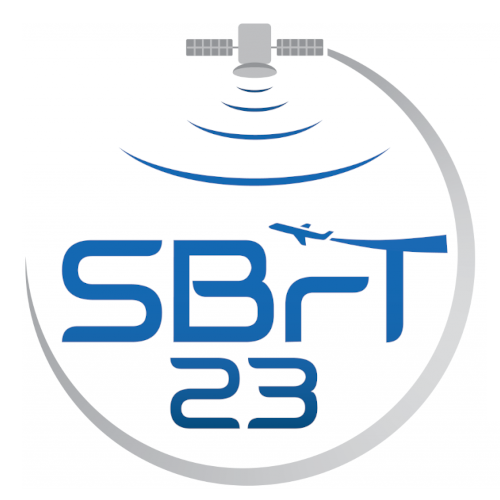
XLI Simpósio Brasileiro de Telecomunicações e Processamento de Sinais
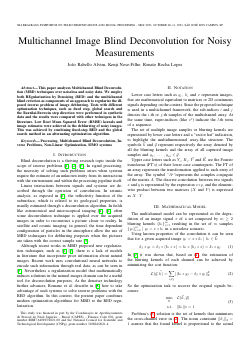
Multichannel Image Blind Deconvolution for Noisy Measurements
Joao Alvim, Kenji Nose Filho, Renato R Lopes
DOI: 10.14209/sbrt.2023.1570915716
Keywords: Multichannel Blind Deconvolution Inverse Problems Non-linear Optimization SIMO systems
Abstract
This paper focuses in the analysis of Multichannel Blind Deconvolution (MBD) techniques over noiseless and noisy data. We use both REgularization by Denoising (RED) and the multichannel blind criterion as a new approach to regularize the ill posed inverse problem of image deblurring. Tests with different optimization techniques, such as fixed step, global search and the Barzilai-Browein (BB) step direction were performed in synthetic data and the results were compared to other techniques in the literature.Download
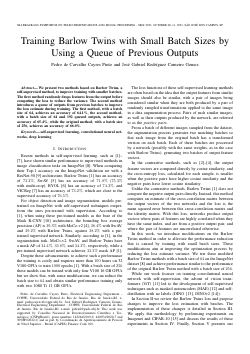
Training Barlow Twins with Small Batch Sizes by Using a Queue of Previous Outputs
Pedro de Carvalho Cayres Pinto, Jose Gabriel Gomes
DOI: 10.14209/sbrt.2023.1570915729
Keywords: self-supervised learning convolutional neural networks deep learning
Abstract
We present two methods based on Barlow Twins, a self-supervised method, to improve training with smaller batches. The first method randomly drops features from the output before computing the loss to reduce the variance. The second method introduces a queue of outputs from previous batches to improve the loss estimate during training. The first method, with a batch size of 64, achieves an accuracy of 64.1%, the second method, with a batch size of 64 and 192 queued outputs, achieves an accuracy of 65.4%, while the original method, with a batch size of 256, achieves an accuracy of 66.0%.Download
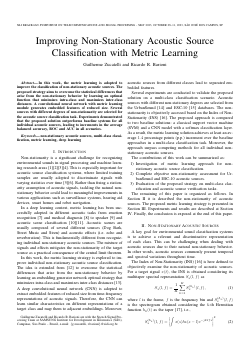
Improving Non-Stationary Acoustic Source Classification with Metric Learning
Guilherme Zucatelli, Ricardo Rossiter Barioni
DOI: 10.14209/sbrt.2023.1570915761
Keywords: non-stationary acoustic sources multi-class classification metric learning
Abstract
In this work, the metric learning is adopted to improve the classification of non-stationary acoustic sources. The proposed strategy aims to overcome the statistical differences that arise from the non-stationary behavior by learning an optimal function that minimizes intra-class and maximizes inter-class distances. A convolutional neural network with metric learning module generates embedded features of reduced size. Several sources with different degrees of non-stationarity are selected for the acoustic source classification task. Experiments demonstrated that the proposed solution outperforms baseline systems for all individual acoustic sources, leading to increments in the average balanced accuracy, ROC and AUC in all scenarios.Download
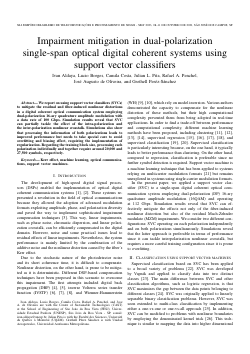
Impairment mitigation in dual-polarization single-span optical digital coherent systems using support vector classifiers
Ivan Aldaya, Lucio Borges, Camila Costa, Julián Pita, Rafael Abrantes Penchel, Jose Augusto de Oliveira, Grethell Georgina Pérez Sánchez
DOI: 10.14209/sbrt.2023.1570915762
Keywords: Kerr effect Machine learning Optical communications Support vector machines
Abstract
We report on using support vector classifiers (SVCs) to mitigate the residual and fiber-induced nonlinear distortions in a digital coherent optical communication system employing dual-polarization 16-ary quadrature amplitude modulation with a data rate of 100 Gbps. Simulation results reveal that SVC can partially tackle the effect of the intra-polarization and the inter-polarization nonlinear crosstalk. Simulations also show that processing the information of both polarizations leads to improved performance but needs to take special care to avoid overfitting and biasing effect, requiring the implementation of regularization. Regarding the training block size, processing each polarization individually and together require around 20,000 and 27,500 symbols, respectively.Download
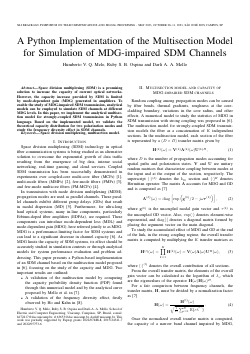
A Python Implementation of the Multisection Model for Simulation of MDG-impaired SDM Channels
Humberto Vinicius Queiroz Melo, Ruby Stella Ospina, Darli Mello
DOI: 10.14209/sbrt.2023.1570915791
Keywords: Space division multiplexing multisection model
Abstract
Space division multiplexing (SDM) is a promising solution to increase the capacity of current optical networks. However, the capacity increase provided by SDM is limited by mode-dependent gain (MDG) generated in amplifiers. To enable the study of MDG-impaired SDM transmission, analytical models can be employed to simulate SDM channels at different MDG levels. In this paper, we implement the analytical multisection model for strongly-coupled SDM transmission in Python language. Based on the implemented model, we validate the theoretical capacity distribution for two polarization modes and study the frequency diversity effect in SDM channels.Download
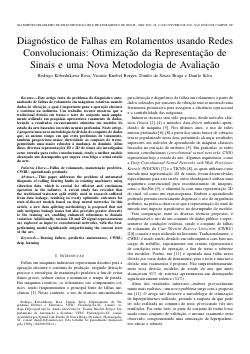
Diagnóstico de Falhas em Rolamentos usando Redes Convolucionais: Otimização da Representação de Sinais e uma Nova Metodologia de Avaliação
Rodrigo K Rosa, Vicente K Borges, Danilo de S. Braga, Danilo Silva
DOI: 10.14209/sbrt.2023.1570915812
Keywords: Bearing failure predictive maintenance CWRU deep learning
Abstract
This paper addresses the problem of automated diagnosis of rolling bearing faults in rotating machinery using vibration data, which is crucial for efficient and continuous operation in the industry. A recent study has revealed that the traditional train-test split widely used in research suffered from data leakage, resulting in overly optimistic outcomes for state-of-the-art models based on deep neural networks. In this article, a new data splitting methodology is proposed that not only mitigates leakage issues but also provides greater diversity to the training set, enabling enhanced robustness to domain variation. Additionally, various 1D and 2D signal representations are explored as input to convolutional networks, with the best-performing model significantly outperforming the current state of the art.Download

Seleção de Hiperparâmetros para o Treinamento das Arquiteturas de Rajpurkar et al. e Ribeiro et al. voltadas à Classificação de Patologias Cardíacas
Roberto Marafon Leandro, Sarah Morgana Meurer, Daniel G. de P. Zanco, Eduardo Vinícius Kuhn, Ranniery Maia
DOI: 10.14209/sbrt.2023.1570915948
Keywords: Busca exaustiva classificação multirrótulo eletrocardiograma
Abstract
Este artigo apresenta uma abordagem sistemática para a seleção de hiperparâmetros no treinamento de duas arquiteturas relevantes de aprendizado profundo da literatura, usadas na classificação de patologias cardíacas. Especificamente, utilizando a base de dados multirrótulo PTB-XL ECG e métricas apropriadas, foi desenvolvido um script em Python para realizar uma busca exaustiva em grade sobre um espaço pré-definido de valores para os hiperparâmetros. Os resultados mostram um desempenho similar para ambas as arquiteturas quando valores apropriados de hiperparâmetros são utilizados.Download
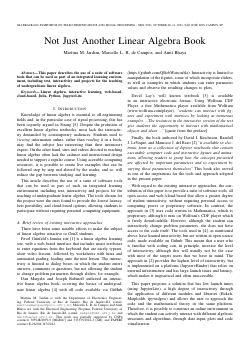
Not Just Another Linear Algebra Book
Martina M. Jardim, Marcello L. R. de Campos, Amit Bhaya
DOI: 10.14209/sbrt.2023.1570916051
Keywords: Linear algebra interactive learning web-based cloud-based Python JupyterLite
Abstract
This paper describes the use of a suite of software tools that can be used as part of an integrated learning environment, including text, interactivity and projects for the teaching of undergraduate linear algebra.Download
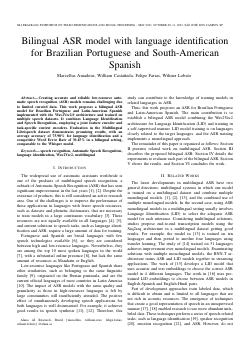
Bilingual ASR model with language identification for Brazilian Portuguese and South-American Spanish
Felipe Farias, William Alberto Cruz Castañeda, Wilmer Lobato, Marcellus Amadeus
DOI: 10.14209/sbrt.2023.1570916069
Keywords: asr language identification
Abstract
Creating accurate and reliable low-resource automatic speech recognition (ASR) models remains challenging due to limited curated data. This work presents the development of a bilingual ASR model for Brazilian Portuguese and South-American Spanish. The model utilizes the Wav2Vec2.0 architecture and is trained on multiple speech datasets. It combines Language Identification and Speech Recognition, employing a joint feature encoder and task-specific context encoders. Evaluation on the Multilingual Librispeech dataset demonstrates promising results, with an average accuracy of 75.98\% for language identification and a competitive Word Error Rate of 30.45\% in a bilingual setting, comparable to the state-of-the-art Whisper model.Download

Receptor BFSK Integrado para HBC baseado da técnica de Injection-Locking
Maicon D Pereira, Marinel B. Almeida
DOI: 10.14209/sbrt.2023.1570916081
Keywords: Redes corporais Baixo consumo Comunicação pelo corpo humano Travamento por injeção
Abstract
A comunicação pelo corpo humano (HBC) é um método de comunicação sem fio para redes corporais que apresenta vantagens com respeito ao consumo, segurança e interferência sobre outros métodos baseados em radiação. Neste trabalho são descritos o projeto e as simulações pós-leiaute de um receptor para HBC com acoplamento capacitivo desenvolvido em tecnologia CMOS 180 nm capaz de demodular sinais BFSK utilizando uma arquitetura que realiza a conversão frequência-fase explorando o fenômeno de injection locking. Os resultados demostram a funcionalidade do receptor para operação na faixa entre 40-60 MHz, com taxas de dados de até 5 Mbps, consumo de 2 mW e eficiência de comunicação de 400 pJ/bit.Download